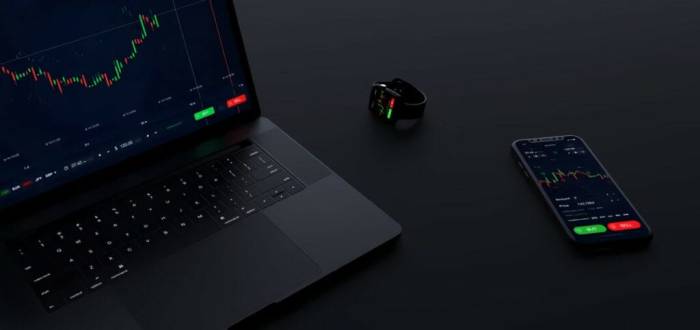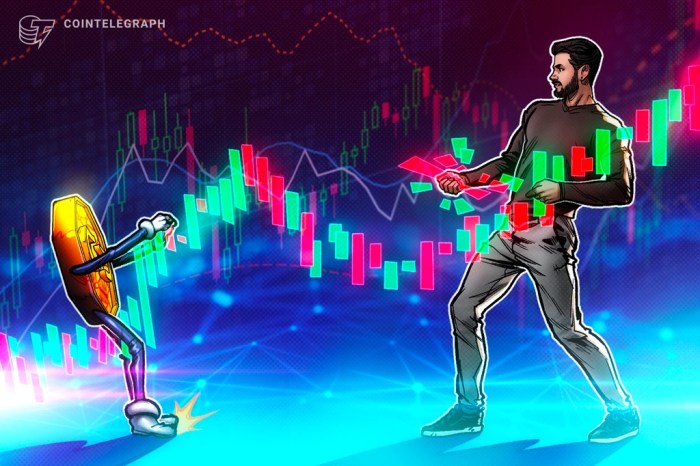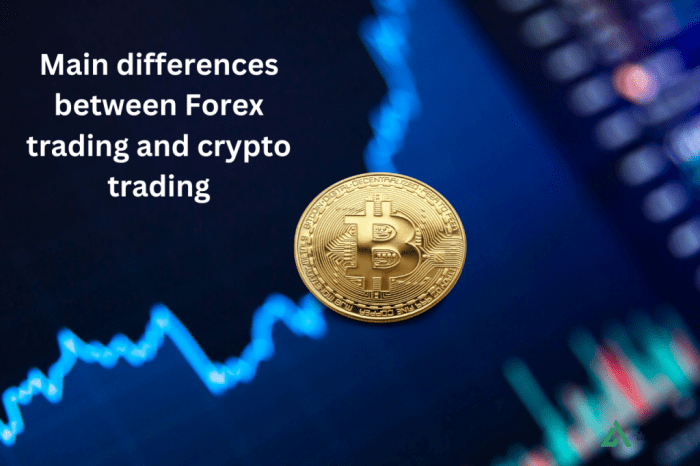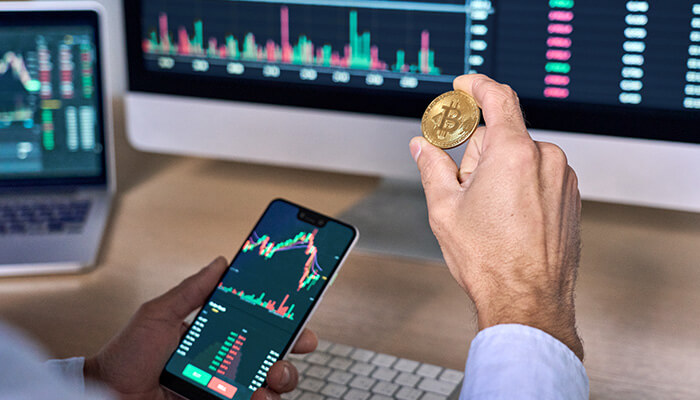
Forex and crypto trading: two wildly different yet strangely similar beasts prowling the financial jungle. One’s a seasoned veteran, steeped in history and regulation; the other, a disruptive newcomer, volatile and brimming with potential. This deep dive explores the fascinating parallels and stark contrasts between these two markets, from their regulatory landscapes to the strategies that can lead to (or wreck) your financial future. We’ll navigate the risks, rewards, and essential tools needed to navigate these complex, ever-evolving worlds.
Whether you’re a seasoned trader looking to diversify your portfolio or a curious newbie dipping your toes into the exciting (and sometimes terrifying) waters of online trading, understanding the nuances of both forex and crypto is key. This guide unpacks the essentials, offering insights to help you make informed decisions and hopefully, profit from your endeavors. Get ready to unravel the mysteries (and the potential millions) behind forex and crypto trading.
Market Comparison: Forex And Crypto Trading
Forex and cryptocurrency markets, while both offering opportunities for significant returns, differ dramatically in their characteristics, regulatory landscapes, and accessibility. Understanding these differences is crucial for any trader looking to navigate these dynamic environments. This section delves into a comparative analysis, highlighting key distinctions to aid in informed decision-making.
Volatility Comparison: Forex vs. Crypto
The volatility of forex and cryptocurrency markets is a significant point of divergence. Forex markets, while experiencing fluctuations, generally exhibit lower volatility compared to cryptocurrencies. The larger size and established nature of the forex market act as a buffer against extreme price swings. However, significant geopolitical events or macroeconomic announcements can still trigger considerable volatility. For example, the 2008 global financial crisis caused significant turmoil in the forex market, leading to sharp depreciations of several currencies. In contrast, the cryptocurrency market is known for its extreme price swings. The relatively smaller market capitalization and susceptibility to speculative trading contribute to this heightened volatility. The 2021 Bitcoin crash, which saw its price plummet by over 50% in a matter of weeks, serves as a stark example of this volatility. Furthermore, news related to regulatory changes, technological advancements, or influential figures can dramatically impact cryptocurrency prices.
Regulatory Landscape: Forex vs. Crypto, Forex and crypto trading
The regulatory landscape for forex and crypto trading varies significantly across different jurisdictions. While forex trading is generally more regulated, the cryptocurrency market is still largely in a nascent stage of regulatory development. The following table summarizes the regulatory environment in three key countries:
| Country | Forex Regulation | Crypto Regulation | Key Differences |
|---|---|---|---|
| United States | Heavily regulated by the Commodity Futures Trading Commission (CFTC) and the National Futures Association (NFA). Brokers must register and comply with stringent rules regarding client funds and trading practices. | Varying state-level regulations; no single federal regulatory body oversees cryptocurrencies. However, the SEC and CFTC are increasingly involved in regulating aspects of the crypto market. | Forex is highly regulated, while crypto regulation is fragmented and still developing. This leads to greater regulatory certainty in forex and higher risks in crypto. |
| United Kingdom | Regulated by the Financial Conduct Authority (FCA), requiring brokers to be authorized and adhere to strict rules on capital adequacy, client protection, and anti-money laundering (AML) measures. | The FCA is increasingly scrutinizing crypto activities, issuing warnings against unregistered firms and focusing on consumer protection. However, a comprehensive regulatory framework is still evolving. | Similar to the US, the UK has a clearer regulatory path for forex compared to crypto, leading to a higher degree of investor protection in forex. |
| Japan | Regulated by the Financial Services Agency (FSA), with stringent rules for forex brokers regarding capital requirements, client segregation, and reporting. | Japan has a relatively progressive approach to crypto regulation, with a licensing system for cryptocurrency exchanges and clear AML/KYC requirements. | While both markets are regulated, Japan demonstrates a more advanced and comprehensive regulatory framework for cryptocurrencies compared to many other nations. |
Trading Hours and Market Accessibility
Forex markets operate 24 hours a day, five days a week, due to the global nature of currency trading. This allows for constant access and trading opportunities across different time zones. Cryptocurrency markets also operate 24/7, reflecting their global and decentralized nature. However, liquidity can vary depending on the specific cryptocurrency and the time of day, with higher trading volumes typically observed during peak hours in major financial centers. The accessibility of both markets is generally high, with online platforms providing access to trading for individuals worldwide. However, access to certain platforms or specific trading instruments may be restricted based on geographic location or regulatory requirements.
Trading Strategies

Forex and cryptocurrency trading, while seemingly disparate, share surprising similarities in their strategic approaches. Both markets leverage technical and fundamental analysis to predict price movements and capitalize on opportunities. However, the specific indicators and underlying economic factors differ significantly, requiring traders to adapt their strategies accordingly.
Technical Analysis Indicators in Forex and Crypto
Technical analysis relies on charting patterns and indicators to identify trends and potential turning points. Many indicators are applicable across both forex and crypto markets, though their interpretation might vary slightly depending on the market’s volatility and liquidity.
- Moving Averages (MA): MAs smooth out price fluctuations, revealing underlying trends. In forex, a 200-day MA is commonly used to identify long-term trends, while in crypto, shorter-term MAs (e.g., 50-day) might be preferred due to higher volatility. A crossover of a short-term MA above a long-term MA is often interpreted as a bullish signal in both markets.
- Relative Strength Index (RSI): RSI measures the magnitude of recent price changes to evaluate overbought or oversold conditions. An RSI above 70 suggests an overbought market (potential for a price correction), while below 30 indicates an oversold market (potential for a price rebound). The interpretation remains consistent across both markets, although the thresholds might need adjustment based on the specific asset’s volatility.
- MACD (Moving Average Convergence Divergence): MACD identifies changes in momentum by comparing two moving averages. A bullish crossover (MACD line crossing above the signal line) suggests increasing upward momentum, while a bearish crossover indicates decreasing momentum. This indicator is used similarly in both forex and crypto trading to spot potential trend reversals.
- Bollinger Bands: Bollinger Bands show price volatility by plotting standard deviations around a moving average. Prices bouncing off the upper band might indicate an overbought condition, while bouncing off the lower band might suggest an oversold condition. This is useful in both markets for identifying potential entry and exit points.
- Fibonacci Retracement: Fibonacci retracement levels identify potential support and resistance levels based on Fibonacci ratios. These levels are used to predict price reversals and potential entry points. The application is consistent in both forex and crypto trading, although the accuracy might vary due to market conditions.
Fundamental Analysis in Forex and Crypto
Fundamental analysis focuses on macroeconomic factors and company-specific data to assess the intrinsic value of an asset. The approach differs significantly between forex and crypto.
Forex trading relies heavily on macroeconomic indicators like interest rates, inflation, GDP growth, and political stability. For example, a rise in US interest rates typically strengthens the US dollar against other currencies, while geopolitical instability can weaken a currency.
Cryptocurrency fundamental analysis focuses on factors like adoption rates, technological advancements, regulatory changes, and the overall sentiment within the crypto community. For example, positive news regarding a cryptocurrency’s technological upgrade or widespread adoption by businesses could drive up its price. Conversely, negative regulatory announcements or security breaches can severely impact a cryptocurrency’s value.
Hypothetical Trading Strategy
Let’s consider a hypothetical strategy combining technical and fundamental analysis.
Forex: EUR/USD
* Fundamental Analysis: Analyze Eurozone and US economic data (e.g., inflation rates, interest rate decisions from the ECB and the Fed). A divergence in monetary policy (e.g., the Fed raising rates while the ECB maintains low rates) could suggest a strengthening US dollar.
* Technical Analysis: Use the RSI and MACD to identify overbought or oversold conditions and potential trend reversals. Entry would be triggered when the RSI shows an oversold condition and the MACD indicates a bullish crossover, suggesting a potential price rebound. Stop-loss and take-profit orders would be placed based on technical support and resistance levels.
Cryptocurrency: Bitcoin (BTC)
* Fundamental Analysis: Monitor news related to Bitcoin adoption by institutional investors, regulatory developments, and technological upgrades. Positive news could signal increased demand and potential price appreciation.
* Technical Analysis: Employ Bollinger Bands and Fibonacci retracement to identify potential support and resistance levels. Entry would be considered when the price bounces off a significant support level (identified by Bollinger Bands or Fibonacci retracement) and shows signs of increasing momentum (e.g., a break above a key resistance level). Stop-loss and take-profit orders would be based on technical levels and risk tolerance.
Risk Management and Security
Navigating the volatile worlds of forex and cryptocurrency trading requires a keen understanding of risk and robust security measures. Ignoring these crucial aspects can quickly lead to significant financial losses. This section delves into the inherent risks and Artikels effective strategies to mitigate them, ensuring your trading journey remains profitable and secure.
Forex and crypto markets are notoriously unpredictable. While the potential for high returns is alluring, the inherent risks must be carefully considered and managed proactively. Failure to do so can result in substantial financial losses, eroding your capital and potentially impacting your overall financial well-being.
Risks Associated with Forex and Crypto Trading
Understanding the potential pitfalls is the first step towards successful trading. Several significant risks are common to both forex and crypto markets, although the specifics can vary.
Examine how ai trading bot forex can boost performance in your area.
- Leverage: While leverage amplifies potential profits, it also magnifies losses. A small market movement against your position can wipe out your entire trading capital if you’re highly leveraged. For example, a 10x leverage on a $1000 trade means a 1% market movement against you results in a 10% loss of your capital ($100).
- Volatility: Both forex and crypto markets are known for their volatility. Sudden and sharp price swings can occur without warning, potentially leading to substantial losses if not properly managed. News events, regulatory changes, and even social media sentiment can trigger significant price fluctuations.
- Security Breaches: Exchanges and trading platforms can be targets for hackers. Security breaches can result in the theft of funds or personal information. This risk is particularly acute in the crypto space due to the decentralized nature of many platforms.
- Liquidity Risk: In less liquid markets, it can be difficult to buy or sell assets quickly at the desired price, potentially leading to slippage or unfavorable execution prices. This is more prominent in some cryptocurrency markets compared to major forex pairs.
- Regulatory Uncertainty: The regulatory landscape for cryptocurrencies is constantly evolving and differs significantly across jurisdictions. This uncertainty can impact the stability and value of certain crypto assets.
Best Practices for Risk Management
Effective risk management is paramount to long-term success in trading. By implementing these strategies, you can significantly reduce your exposure to potential losses.
Learn about more about the process of how to read forex trading charts in the field.
- Stop-Loss Orders: These orders automatically close your position when the price reaches a predetermined level, limiting potential losses. Setting appropriate stop-loss levels is crucial to protect your capital.
- Position Sizing: Never risk more than a small percentage of your trading capital on any single trade. A common rule of thumb is to risk no more than 1-2% per trade. This helps to prevent catastrophic losses even if multiple trades go against you.
- Diversification: Don’t put all your eggs in one basket. Diversify your portfolio across different assets to reduce the impact of losses in any single position. This applies to both forex (trading different currency pairs) and crypto (investing in various cryptocurrencies).
- Regular Reviews: Periodically review your trading performance and adjust your risk management strategy as needed. Track your wins and losses, identify patterns, and adapt your approach based on your findings.
Security Measures for Trading Accounts
Protecting your trading accounts and funds is crucial. Implementing strong security measures is essential to prevent unauthorized access and potential losses.
- Strong Passwords: Use unique, complex passwords for each trading platform and avoid reusing passwords across different accounts.
- Two-Factor Authentication (2FA): Enable 2FA whenever possible to add an extra layer of security. This typically involves using a code from an authenticator app in addition to your password.
- Regular Software Updates: Keep your trading platform software and operating system up-to-date to patch security vulnerabilities.
- Secure Internet Connection: Avoid trading on public Wi-Fi networks, as these are more vulnerable to hacking attempts. Use a VPN for added security when using public Wi-Fi.
- Beware of Phishing Scams: Be cautious of suspicious emails or messages requesting your login credentials. Legitimate trading platforms will never ask for your password via email.
Comparison of Security Features Across Trading Platforms
Security features vary across different trading platforms. It’s essential to research and choose a platform that offers robust security measures.
| Platform | 2FA | Withdrawal Limits | SSL Encryption | Security Audits |
|---|---|---|---|---|
| Platform A | Yes | Variable | Yes | Annually |
| Platform B | Yes | High | Yes | Semi-annually |
| Platform C | No | Low | Yes | Not publicly available |
Trading Platforms and Tools

Navigating the forex and crypto markets successfully hinges on choosing the right tools and platforms. The sheer variety available can be overwhelming, but understanding the key features and functionalities is crucial for optimizing your trading experience and maximizing your potential. This section will delve into the specifics of popular platforms, the diverse tools available, and how to select the perfect fit for your individual trading style.
Comparison of Forex and Crypto Trading Platforms
Choosing a trading platform is a critical first step in your trading journey. Different platforms offer varying features, levels of security, and pricing structures. The following table compares some popular options, highlighting their strengths in both forex and crypto trading. Note that features and pricing can change, so always verify directly with the provider.
| Platform Name | Forex Features | Crypto Features | Pricing |
|---|---|---|---|
| MetaTrader 4 (MT4) | Widely used, extensive charting tools, automated trading (Expert Advisors), vast range of indicators, large community support. | Limited crypto support, often requires bridging with other platforms. | Generally commission-based, with varying spreads depending on the broker. |
| MetaTrader 5 (MT5) | Improved version of MT4, offers more advanced order types, economic calendar integration, and enhanced charting capabilities. | Better crypto support than MT4, but still may lack the breadth of dedicated crypto exchanges. | Similar to MT4, commission-based with variable spreads. |
| cTrader | Fast execution speeds, advanced charting, algorithmic trading capabilities, and a user-friendly interface. | Limited or no direct crypto trading support. | Commission-based, often with competitive pricing. |
| Binance | Limited forex offerings, often through CFDs. | Extensive range of cryptocurrencies, spot trading, futures, margin trading, and staking options. Advanced charting tools and order types. | Variable fees depending on trading volume and used features. |
| Coinbase Pro | No forex trading. | Large selection of cryptocurrencies, user-friendly interface, robust security measures. | Variable fees depending on trading volume and used features. |
Trading Tools: Charting Software, Automated Trading Bots, and Analytical Tools
Beyond the core platform, numerous tools can enhance your trading performance. These tools can range from simple charting software to sophisticated automated trading systems and complex analytical packages. Effective use of these tools is vital for informed decision-making.
Charting software allows for visual representation of price movements, identification of trends, and technical analysis. Automated trading bots, or Expert Advisors (EAs) in MT4/MT5, execute trades based on pre-programmed rules, potentially freeing up time and reducing emotional biases. Analytical tools provide deeper insights into market data, helping to identify potential opportunities and risks. These can include indicators, oscillators, and other mathematical models. For example, moving averages help smooth out price fluctuations to identify trends, while RSI (Relative Strength Index) measures the momentum of price changes.
Choosing a Suitable Trading Platform
Selecting the right platform depends heavily on your individual needs and trading style. Consider the following factors:
* Trading Style: Scalpers might prioritize speed of execution, while long-term investors may focus on charting tools and fundamental analysis capabilities.
* Asset Classes: If you primarily trade forex, a platform with strong forex features and low spreads is essential. If crypto is your focus, choose a platform with a wide selection of cryptocurrencies and advanced trading features.
* Fees and Commissions: Compare pricing models carefully, including spreads, commissions, and any other fees.
* Security: Prioritize platforms with robust security measures, including two-factor authentication and cold storage for cryptocurrencies.
* User Interface: A user-friendly interface can significantly improve your trading experience. Consider testing out demo accounts before committing to a live account.
Educational Resources and Community

Navigating the often-turbulent waters of forex and crypto trading requires more than just gut feeling and a lucky streak. Solid education and a supportive community are your anchors in this volatile market. Without them, you’re essentially sailing blind, susceptible to scams and misinformation that can quickly sink your investment.
Learning to trade forex and crypto isn’t a get-rich-quick scheme; it’s a skill that demands consistent effort and a commitment to lifelong learning. This involves not only mastering the technical aspects but also developing a strong understanding of risk management and cultivating a network of fellow traders for support and shared knowledge.
Reputable Educational Resources
Finding reliable learning materials is crucial for success in forex and crypto trading. Beware of flashy promises and focus on resources that prioritize education over profit. A well-rounded approach should include various learning styles and perspectives.
- Books: “Japanese Candlestick Charting Techniques” by Steve Nison provides a foundational understanding of candlestick patterns, while “Trading in the Zone” by Mark Douglas focuses on the psychological aspects of trading. Many excellent books delve into specific strategies for forex and crypto, so research based on your chosen market is key.
- Websites: Websites like Investopedia and Babypips offer comprehensive educational resources, covering everything from fundamental analysis to risk management. However, always critically evaluate the information you find online, as not all sources are created equal.
- Online Courses: Platforms like Coursera, edX, and Udemy offer various courses on forex and crypto trading, ranging from beginner to advanced levels. Look for courses taught by experienced professionals with verifiable credentials and positive student reviews.
Community Engagement and Networking
The forex and crypto trading world thrives on community. Connecting with other traders provides invaluable benefits, from sharing insights and strategies to receiving support during challenging times. Engaging with a community can help you learn from others’ mistakes and avoid common pitfalls.
Participating in online forums, attending webinars, and joining local meetups can expand your network and expose you to different perspectives. Remember, collaboration and shared knowledge are crucial for navigating this complex landscape. However, always be cautious and avoid blindly following the advice of others without independent verification.
Identifying and Avoiding Scams and Misinformation
The forex and crypto markets are unfortunately rife with scams and misinformation. These schemes often promise unrealistic returns and prey on the hopes of inexperienced traders. Recognizing these scams requires vigilance and a healthy dose of skepticism.
- Guaranteed Returns: Any investment opportunity promising guaranteed returns is almost certainly a scam. Trading involves inherent risk, and no one can guarantee profits.
- High-Pressure Sales Tactics: Be wary of anyone who pressures you into making quick decisions or investing large sums of money without proper research.
- Unverified Testimonials: Testimonials are often fabricated or manipulated. Look for independent reviews and verification before trusting any claim.
- Unrealistic Promises: Be skeptical of claims promising overnight riches or extremely high returns with minimal risk. These are red flags for potential scams.
Epilogue
So, forex and crypto trading: a thrilling rollercoaster ride with the potential for massive gains, but also for equally significant losses. The key takeaway? Thorough research, disciplined risk management, and a healthy dose of patience are your best allies. Understanding the unique characteristics of each market, coupled with a robust trading strategy and a commitment to continuous learning, will significantly improve your chances of success. Don’t just jump in; dive in strategically. Your financial future might depend on it.





